Menus
- The large scooters from BMW, Honda and Yamaha in comparison
- Large scooters in comparison
- Rating: City
- Rating: country road
- Rating: overall
- Technical specifications
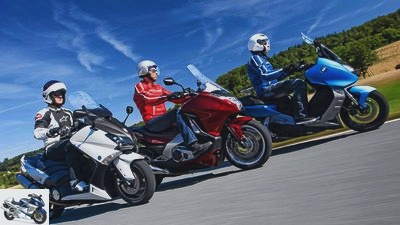

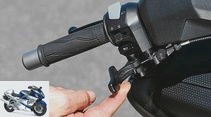

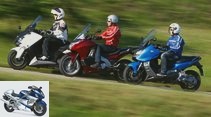
17th photos
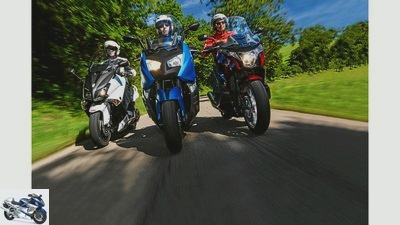
1/17
Here it comes: the scooter guard of motorcycle veterans BMW, Honda and Yamaha and faces the class comparison.

2/17
Test scenario number 1: The stopover in the cafe – only where to go with the helmet? Right, in the storage compartment.
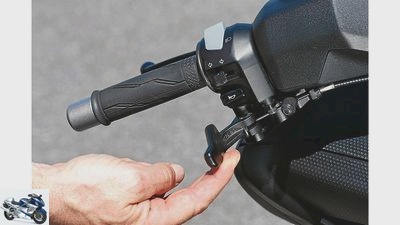
3/17
Good solution from Yamaha: the parking brake by hand lever on the handlebars – pushing is also possible with the side stand folded out
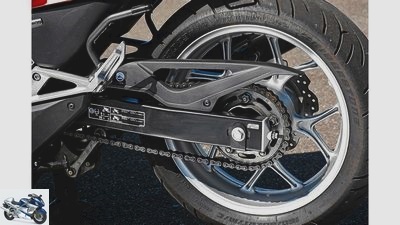
4/17
The drive at Honda runs via a chain: The open secondary chain testifies to the motorcycle genes of the Integra – and a tight calculation.
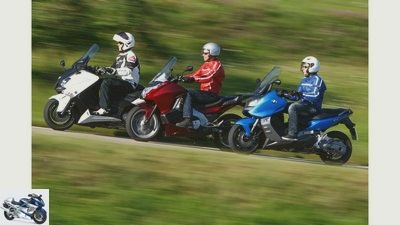
5/17
The three large scooters from BMW, Honda and Yamaha competed against each other not only in the city – they also had to prove themselves on the country road. Next test: the drive.
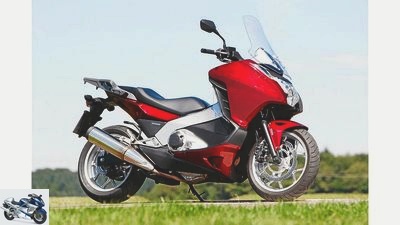
6/17
With the cheapest Honda Integra, the Japanese from Tokyo send the cheapest scooter into the race. The Integra starts with a base price of 7990 euros with a 670 cm³ engine and 52 hp.
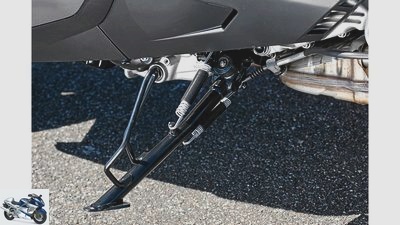
7/17
A very good solution for the BMW: the side stand automatically activates the rear brake via a cable when unfolding.
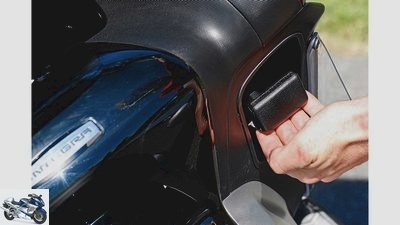
8/17
The Integra also needs a separate lever: the parking brake is activated on the right-hand side of the center tunnel.
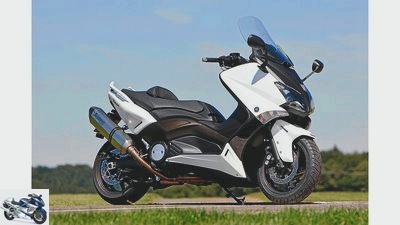
9/17
With the TMax, Yamaha sends the weakest large scooter into the race: Its 47 hp is drawn from the 530 cc engine. In terms of the basic price, however, it is only slightly behind the BMW at 11,970 euros.
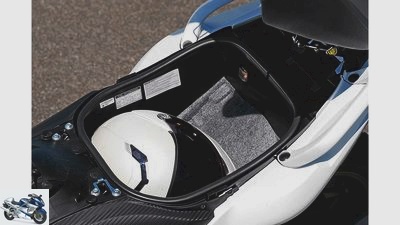
10/17
Very good standard: The helmet compartment of the TMax offers space for a full-face helmet and is – like that of the BMW – illuminated.
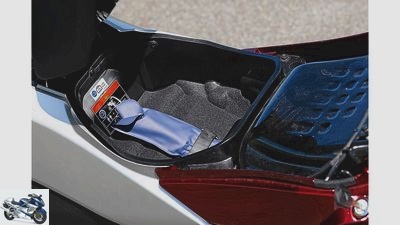
11/17
Is there room even in the smallest hut? Are you kidding me? Are you serious when you say that. Only a jet helmet fits in the Honda storage compartment – without a visor.
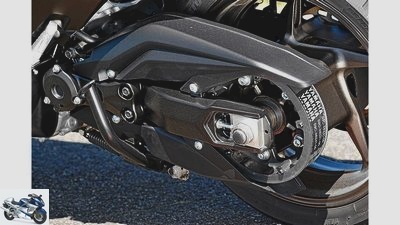
12/17
Yamaha donated a belt: For the 2012 model year, the TMax was given an easy-care belt drive instead of the previously used chain
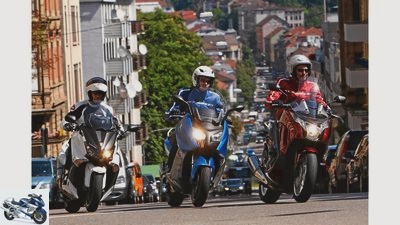
13/17
Scenario number 2: When taking a break, the scooter also wants to be parked – on the mountain with a parking brake.
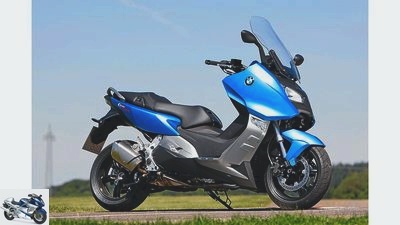
14/17
The BMW C 600 Sport compares with 647 cm³ displacement, 60 hp and a cost price of 11,100 euros.
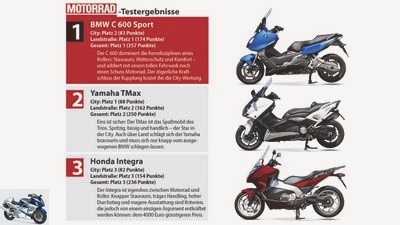
15/17
Despite small mistakes in the city ranking, the BMW C 600 Sport was at the top of the podium in the end. With first place in the city ranking, the Yamaha TMax takes second place in the overall ranking. The Integra impresses with an impeccable entry-level price, but due to the poor equipment and the sluggish handling it is only enough in third place.
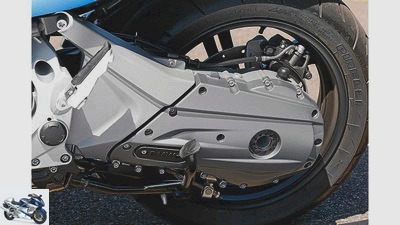
16/17
At BMW, the chain is in an oil bath – only cardan would be better. By the way: The rocker arm and the chain pinion are mounted coaxially on a common shaft.
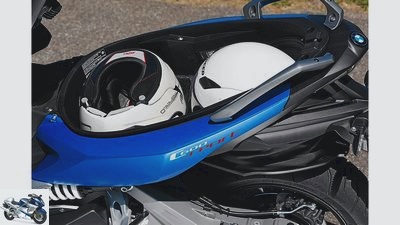
17/17
Simply ingenious: The Flex Case (textile bag above the rear wheel) allows the BMW to hold two full-face helmets.
Comparison test: BMW C 600 Sport, Honda Integra and Yamaha TMax
The large scooters from BMW, Honda and Yamaha in comparison
Sufficient power, decent chassis, automatic – and dry feet. Large scooters interpret the subject of two-wheelers in their own way. Now BMW and Honda are launching a new fragrance in this segment. In comparison: the BMW C 600 Sport, the Honda Integra and the Yamaha TMax.
Large scooters in comparison
In Barcelona, Milan or Marseille they meander through the traffic chaos in droves. In the metropolises of southern Europe, large scooters are considered to be an effective medicine against traffic blackouts and parking problems. For example, the sold in Italy alone Yamaha TMax over 180,000 times. After Berlin, Dusseldorf or Frankfurt, however, the spark jumped only tentatively.
Buy complete article
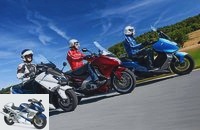
Comparison test: BMW C 600 Sport, Honda Integra and Yamaha TMax
The large scooters from BMW, Honda and Yamaha in comparison
Yamaha TMax significantly spiced up this season. How are the new scooters doing in town? And how much driving fun they offer in the country?
Rating: City
Storage space, stress-free automatic drive, low step-through and pronounced weather protection – scooters show their conceptual advantages in the city.
The gate of the editorial garage rattles upwards. The three scooter drivers slide into the dense city traffic. Is it because of jeans or a jet helmet? The unfamiliar driving experience? Or just a newly adjusted personal basic setting? However, the otherwise hated traffic inferno suddenly mutates into a sporting challenge. The narrow lane between the cars is transformed into a test track for a sense of proportion, a sense of balance and steering precision.
Take it, take it, before the sporting spirit gets away with us. Winding through is tolerated at best, not allowed. And these scooters are not used for pubescent city racing, but are the result of clear calculations: They combine the advantages of single-track travel as well as possible with automotive comfort. Urban Mobility. Commuting without traffic jams, shopping without the hassle of looking for a parking space. On top of that, low-stress thanks to the automatic transmission, largely weather-protected thanks to the leg shield with front window and functional thanks to integrated storage space. Sounds sensible, but not very tingly. But the fun comes from somewhere else. Motorcycle boots? Would definitely be safer. But if you don’t have to shift gears, you won’t get black welts on your left shoe. Well then, comfortable sneakers. And jeans and leather jackets are enough for the city anyway.
Simply ingenious: thanks to the Flex Case (textile bag above the rear wheel), the storage space of the BMW C 600 Sport holds two full-face helmets.
We carefully meander along the lines of cars. Often every inch counts. It is smart that the rearview mirrors of the BMW and Yamaha scooters attached to the body can be folded away forwards, while the Honda mirrors are fixed immovably on the handlebar. A consolation that the fairy tale of envious drivers has had its day.
Many chauffeurs pull their car aside in an accommodating manner. Merci. And even for those who have easily mastered the game of gas and clutch, the automatic transmission means relief in stop-and-go traffic. Accelerate, brake, and that’s it. No fear of stalling, concentration on the essentials – that can also mean driving pleasure. While BMW and Yamaha use a conventional belt variator, the double-clutch transmission of the Honda feels different at the jerky pace. The frictional connection is more direct due to the conventional gear transmission, short thrusts of the gas, for example to pierce a gap, the Integra drive train responds more spontaneously, even measurably faster.
Good solution: the parking brake by hand lever on the handlebars – pushing is also possible with the stand folded out.
For the lightning sprint from zero to 30 km / h, the Honda Scooter just under 0.2 seconds from the TMax and 0.4 seconds from the C 600 (see technical data). In this speed range, a difference that should not be underestimated. Nevertheless, the 239 kilogram Integra cannot hide its pounds, and in all situations it feels even more sluggish than the 13 kilogram heavier BMW (252 kg). This is where the Yamaha’s hour strikes (218 kg). Right, left, right, the TMax jumps from track to track as effortlessly as Gold-Rosi once did through the slalom poles. It benefits not only from its moderate weight, but also from its lively engine. Probably thanks to the Akrapovic silencer (surcharge 975 euros), the 530 engine, which is kept in the relatively high speed range by the variator, bites lively and is subjectively more agile than the Honda Twin.
The Honda Integra impresses with its stoically calm driving style – but the comfortable suspension quickly reaches its limits on bumpy slopes.
The fear of a competitive traffic light start, which is often present with small-displacement scooters, is not an issue for the fat ones. Accelerating the common citizen cage is easy. For everyone. Gas up and down you go. It feels like the lively Yamaha sprints forward again, measured the Honda remains the boss. An illusion that, apart from the robust sound of the Akrapovic damper, is also caused by the high speed level when accelerating the TMax drive. And while the Honda’s automatic transmission barely noticeably but efficiently switches through in Sport mode, the BMW is the gentlest to work. Eminently smooth, almost too tender for some tastes and a little delayed, the C 600 picks up speed. We park the three in front of a cafe. Again, every inch counts. This time during the ascent. There is no free passage à la Vespa and Co. with the motors housed in the front of the chassis in favor of an even weight distribution. The scooter troop doesn’t need to be sporty though. Even pensioners’ legs can easily be lifted over the hurdle of almost 60 centimeters (BMW and Yamaha). Only for the Honda step-through (73 centimeters) you need a little more momentum.
Katrin Sdun
The winner of the city classification is the TMax from Yamaha.
It is hot. Helmet, jacket, gloves interfere. Where? Logically, in the storage compartment. False report for the Honda driver. Not even a jet helmet with a lens fits under the seat of the Integra. In the constructive counterpart of the scooter, the technically almost identical NC 700, a helmet can easily be accommodated in the dummy tank. The TMax driver can only grin at this. The trunk of the Yamaha easily swallows a full-face helmet, small items fit – as with the BMW – in lockable shelves in the front panel. The BMW driver pulls the joker. Directly next to the helmet compartment under the seat bench, a so-called flex case, a textile bag that extends almost to the rear wheel with space for another full-face helmet, can also be unfolded. Brilliant. This can also be fun.
Nevertheless: The bustling handling, the low weight and the spontaneous acceleration compared to the BMW make the TMax the ruler between underground parking and ice cream parlor. The Honda lacks the agility and the offer in terms of storage space. By the way: the bill, please, we’re going to the country…
Rating: country road
Don’t be afraid of curves. On the country road, large scooters surprise with a handling that comes astonishingly close to conventional motorcycles.
Convinced. In the city, scooters really are the better motorcycles. It may be that the sprint from traffic light to traffic light is less spectacular or the status cannot compete with a super athlete. But viewed objectively, scooters offer clear advantages: Hardly any motorcycle concept combines wind and weather protection, storage space, a user-friendly automatic transmission and low seat height as homogeneously as a scooter. But while this job can also be done by a 125cc or 250cc scooter in an urban environment, the large scooters not only expand the potential commuter radius, but also offer driving characteristics that are significantly closer to conventional motorcycles than those of their smaller brothers. They have to, because in terms of price, the large scooter faction is huge. An upper mid-range bike can also be financed for the tariff for the BMW and Yamaha, which cost a good 11,000 euros. The Honda Integra is calculated much more moderately for a little more than 8000 euros. However: In the USA the TMax costs 8590 dollars (around 7050 euros) a third less, the US price for the BMW has not yet been set.
So out to the country. There is no rush hour yet. The feeder road washes us onto the motorway in no time at all. If so, then already. Third track, see what’s up. The most powerful of the three engines, the newly developed 650 series BMW engine, produces 60 hp. There are 47 HP left on the rear wheel. Not bad for a vario drive. 39 HP arrive at the 530 Yamaha propellant (nominal output 47 HP) at the rear wheel. Only the Honda remains mysterious. The nominal 52 hp Integra could not be measured on the MOTORRAD test bench. When the front wheel is stationary, the Honda electronics jumps to an emergency running program. So so, on the train, the small group, no matter how contemplative in the city, is a threesome. The data recording will later produce 163 km / h for the Honda and the Yamaha. Nothing wobbles, nothing lurches – the drivers only winced because of the BMW. Because it rushes past its colleagues with a marked excess of speed, is only slowed down hard by the rev limiter at a measured 181 km / h. It is impressive how impressive ten horsepower more power can be.
Chain: The open secondary chain testifies to the motorcycle genes of the Integra – and a tight calculation.
Especially since the BMW player doesn’t even have to crouch down for the express train speed. The largest pane in the test field can be easily adjusted manually in three positions. The steepest incline offers almost perfect wind protection, but creates a negative pressure that takes getting used to at higher speeds. Significantly less, but still acceptable, the TMax’s screen, which is mounted in the higher of the two positions, protects the most draughty from the comparatively low, non-adjustable Honda screen. Enough now, speed out, blink, exit. A look in the rearview mirror. Only the BMW mirrors are a bit narrow, depicting the driver’s elbows. Integra and TMax offer more consideration.
Finally no more lines of cars, no traffic lights, no expensive cafes. Instead, curved country roads and bumpy provincial roads. Motorcyclist, uh, big scooter country. It sits comfortably on half a car. Pleasant 90-degree knee angle, well-padded, wide seats, designed for the eternal ride. And yet different. Sporty, with relatively low handlebars, slightly bent forward, you reside on the Yamaha, more relaxed, but somewhat inactive on the Honda. Long boys and girls occasionally bump their knees against the body of the Integra. The BMW meets the golden mean. In addition, it spoils the driver with the greatest amount of space for the rear and legs – even if the pillion is the most flattering of the beautifully shaped Yamaha passenger seat. The asphalt is still smooth, t and the three of them are making their lane perfectly. It is no coincidence that the chassis geometries (technical data) are based on those of conventional machines.
Chain in an oil bath: only cardan would be better. By the way: The rocker arm and chain pinion are coaxially supported on a common shaft.
Only when the asphalt ripples do the scooters lose a bit of their composure, proving once again that the key to successful maneuverability is not just the low center of gravity. The cylinders of the scooter twins (BMW 70 degrees, Honda 62 degrees, Yamaha 80 degrees), which are extremely flat because of the deep step-through, seem to have little effect on handling. Of all things, the Honda, the only scooter with 17-inch wheels, is what causes bumpy roads the most. As easily as the comfortably coordinated Integra can handle individual waves, its suspension quickly reaches its limits on washboard slopes. Then the softly sprung and cushioned Honda rocks up, nervously pumping itself through the suspension travel. There is little left of his stoic calm, especially when he is inclined. Quickly you voluntarily strike a somewhat more moderate rhythm. Which, however, does not completely bring back the driving pleasure. As long as it remains curvy, the Integra feels – as in the city – significantly more sluggish than the competition.
The winner of the country road classification is the BMW C 600 Sport.
Which, however, does not completely bring back the driving pleasure. As long as it remains curvy, the Integra feels – as in the city – significantly more sluggish than the competition. The Yamaha remains true to its bustling character, which has already been attested in town, even on outdoor excursions. He turns corners on his 15-inch tires and with his comparatively stiff suspension is quite unabashedly the athlete. One likes to swap the comfort of the Honda for the predictability and the larger chassis reserves of the TMax on the country road. Especially since the series tuning is set for both. Neither fork nor shock absorber can be adjusted.
Rating: overall
Large scooter test: BMW C 600 Sport, Honda Integra and Yamaha TMax in comparison.
Even if the BMW with a monoshock that can only be adjusted in the spring base does not offer much more tuning potential in this respect, the Bavarian still plays in a different league in terms of driving behavior. Homogeneously balanced, the C 600 Sport darts into the corners on its 15-inch Pirelli-tyred wheels, effortlessly stays in lane with astonishing steering precision and conveys a level of trust previously unknown in this segment. If a scooter comes close to the handling of a motorcycle, it is the BMW. The engine of the C 600 matches this in character. In the city, still gentle and reserved, not least due to the delayed variator, the twin gets in shape in the country road relevant range between 60 and 120 km / h. He pushes forward powerfully, loosely distancing the Integra and the Yamaha and ultimately rounding off the victory in the country road classification. The Honda shows two faces. In D mode, the automatic shifts up early and lets the vehicle chug through the landscape at low revs. Only the S-stage elicits adequate liveliness from the 670 two-cylinder.
Even if he runs out of breath early at higher engine speeds – for example when overtaking. And the Yamaha engine? Make a good face to the game, which is actually not that fast. The rich sound and the high speed level give the impression of a powerful bite. But even if the stopwatches convict the cheeky blender, he’s still fun. If only because – just like the BMW – it allows tight lean angles in solo operation. A gas station. Quick in the iron. Oh, it didn’t have to be that vehement. Calm down, ABS is standard equipment in the trio. Short braking distances due to the concept-related deep and elongated roller geometry obviously too. From 100 km / h the excellently regulating Honda is after 38.2 meters. Even the 39.4 meters required by the BMW and 40.6 meters required by the Yamaha are top values. For comparison: mid-range machines also need more than 40 meters.
The overall winner is the BMW C 600 Sport.
But consumption also remains at motorcycle level. The twins of the BMW and the Yamaha dump 4.3 and 4.4 liters respectively to 100 kilometers, while the Honda with 3.7 liters brings a moderate fuel bill. We scooter back towards the big city. Time to ponder. On the country road, the BMW has rehabilitated itself with a balance and steering precision that is astonishing for this concept and with a powerful engine. Despite the great handling, the TMax with its pleasurable but less potent engine ultimately has to admit defeat in the wild. And the Honda proves that universal concepts like the Integra can be offered in a more financially attractive way, but also require many compromises.
Technical specifications
Large scooters in comparison: BMW C 600 Sport, Honda Integra and Yamaha TMax
| BMW C 600 Sport | Honda Integra | Yamaha Tmax | engine |
| design type | Two-cylinder four-stroke in-line engine | Two-cylinder four-stroke in-line engine | Two-cylinder four-stroke in-line engine |
| Four-stroke in-line engine | Two-cylinder- | ||
| Four-stroke in-line engine | Two-cylinder- | ||
| Four-stroke in-line engine | |||
| injection | Ø 38 mm | Ø 38 mm | Ø 36 mm |
| transmission | Stepless belt automatic | Double clutch | Stepless belt automatic |
| Bore x stroke | 79.0 x 66.0 mm | 73.0 x 80.0 mm | 68.0 x 73.0 mm |
| Displacement | 647 cm3 | 670 cm3 | 530 cm3 |
| compression | 11.6: 1 | 10.7: 1 | 10.9: 1 |
| power | 44.0 kW (60 hp) | ||
| at 7500 rpm | 38.1 kW (52 hp) | ||
| at 6250 rpm | 34.2 kW (47 hp) | ||
| at 6750 rpm | |||
| Torque | 66 Nm at 6000 rpm | 62 Nm at 4750 rpm | 52 Nm at 5250 rpm |
| Final drive | Chain in an oil bath | Chain | V-belt |
| landing gear | |||
| frame | Steel tubular frame with screwed cast aluminum parts | Bridge frame made of steel | Tubular frame made of aluminum |
| aluminum | |||
| fork | Upside-down fork, Ø 40 mm | Telescopic fork, Ø 41 mm | Telescopic fork, Ø 43 mm |
| Brakes v / h | Ø 270/270 mm | Ø 320/240 mm | Ø 267/282 mm |
| Assistance systems | SECTION | SECTION | SECTION |
| bikes | 3.50 x 15; 4.50 x 15 | 3.50 x 17; 4.50 x 17 | 3.50 x 15; 5.00 x 15 |
| tires | 120/70 R 15; 160/60 R 15 | 120/70 R 17; 160/60 R 17 | 120 / 70R 15; 160 / 60R 15 |
| Tires v / h | Pirelli Diablo Scooter | Bridgestone BT 023 “G” | Bridgestone BT 011 “E” / BT 012 “E” |
| Dimensions + weights | |||
| wheelbase | 1591 mm | 1525 mm | 1580 mm |
| Steering head angle | 64.6 degrees | 63.0 degrees | 62.0 degrees |
| trailing | 92 mm | 110 mm | 95 mm |
| Suspension travel v / h | 115/115 mm | 120/120 mm | 120/116 mm |
| Seat height 1 | 810 mm | 800 mm | 795 mm |
| Weight with full tank 1 | 252 kg | 239 kg | 218 kg |
| Payload 1 | 193 kg | 194 kg | 197 kg |
| Tank capacity | 16.0 liters | 14.1 liters | 15.0 liters |
| Service intervals | 10,000 km | 12,000 km | 10,000 km |
| price | 11 100 euros | 7990 euros | 10 995 euros |
| Price test scooter | 11,990 euros² | 7990 euros | 11,970 euros³ |
| Additional costs | 390 euros | 265 euros | 150 euros |
| MOTORCYCLE readings | |||
| Top speed | 181 km / h | 163 km / h | 163 km / h |
| acceleration | |||
| 0-30 km / h | 1.7 sec | 1.3 sec | 1.5 sec |
| 0-60 km / h | 3.5 sec | 3.1 sec | 3.4 sec |
| 0-100 km / h | 6.8 sec | 6.7 sec | 7.4 sec |
| 0-140 km / h | 12.9 sec | 15.0 sec | 16.3 sec |
| 60-100 km / h | 3.3 sec | 3.6 sec | 4.0 sec |
| 100-140 km / h | 6.1 sec | 8.3 sec | 8.9 sec |
| Braking distance from 100 km / h | 39.4 m | 38.2 m | 40.6 m |
| Consumption highway | 4.3 liters | 3.7 liters | 4.4 liters |
| Reach country road | 372 km | 381 km | 341 km |
Related articles
-
Eight large touring motorcycles in a comparison test
Photo: 24 photos 1/24 BMW R 1200 GS Rallye, Moto Guzzi Stelvio 1200 8V, Triumph Tiger Explorer, KTM 990 Adventure, Kawasaki…
-
Honda Integra scooter in the test
Honda 24 photos Manufacturer 1/24 Manufacturer 2/24 Manufacturer 3/24 Manufacturer 4/24 Manufacturer 5/24 Manufacturer 6/24 Manufacturer 7/24…
-
Kymco AK 550i and Yamaha TMax DX in comparison test
markus-jahn.com Kymco AK 550i and Yamaha TMax DX in comparison test Maxi scooter in comparison test That doesn’t exist. There is, at Roll … uh …
-
BMW C 650 GT scooter in the test
fact In the test: BMW C 650 GT 650 scooter from BMW Sorry, dear BMW designers, but from the front your scooter looks like a sea bream. Let’s see if he…
-
Middle-class all-rounder in a comparison test
markus-jahn.com 31 pictures markus-jahn.com 1/31 mid-range all-rounder in comparison test – Honda Crossrunner, Kawasaki Versys 1000, Triumph Tiger 1050 …
-
Comparison test: athletes against touring athletes
25 pictures 1/25 Concept comparison: super athletes versus touring athletes from Honda and Kawasaki. In the test: Kawasaki Ninja ZX-10R, …
-
Comparison test: large naked bikes
fact Comparison test: Large naked bikes, BMW K 1300 R, Honda CB 1300 S, Suzuki B-King, Yamaha XJR 1300 Large naked bikes in comparison Content of An…
-
Adventure enduros in comparison test
Jahn 44 photos markus-jahn.com 1/44 Triumph Tiger 800 XCA. markus-jahn.com 2/44 Honda CRF 1000 L Africa Twin. markus-jahn.com 3/44 Honda CRF 1000 L…
-
Comparison test: 17 hp motorcycles
Comparison test, Honda CB Two Fifty, Honda CMX 250 Rebel, Kawasaki Estrella 250, Yamaha XV 250 17 hp motorcycles Because of the sports boom and chopper…
-
BMW, Kawasaki, Triumph and Yamaha Tourer in comparison test
Gargolov 31 photos Gargolov 1/31 Tourer comparison test: Triumph Trophy SE, BMW R 1200 RT, BMW K 1600 GT, Yamaha FJR 1300 and Kawasaki 1400 GT. Gargolov…